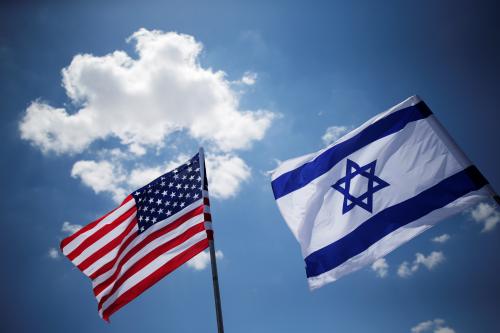The United States has just signed an unprecedented military aid deal with Israel totaling $38 billion. What’s remarkable about the agreement is that the United States is committing to significant levels of aid to Israel over a period of 10 years.
The fact that Israel is the recipient of the largest share of U.S. foreign aid is not new—Israel has held that position for decades. But recall that when the United States first committed to significant levels of aid to Israel (about $3 billion per year), it was part of a package that rewarded Egypt and Israel for signing the Camp David agreement, which the United States deemed strategically beneficial. It was an incentive for historic moves: Israel withdraws from the Egyptian territories it occupied in 1967 while Egypt makes peace with Israel, abandons the Soviet Union, and tilts toward Washington. Levels of combined aid to Egypt have significantly dropped since.
In this case, Israel is making no major strategic decision to attract this level of aid—and certainly not one over the Palestinian-Israeli or the broader Arab-Israeli conflicts. There has been significant and continuing U.S.-Israeli cooperation on a host of military and intelligence issues pertaining to common interests. But it’s not obvious to the public if there is any new element to the relationship—other than codifying the current strategic relations, over the period of a decade, with an increased price tag (although media reports also suggest that the memorandum of understanding precludes Israel seeking supplemental aid which it had often sought from Congress, and which sometimes accounted for inflation and unexpected expenses).
Do Americans support such an aid package?
I asked about this issue in my May 2016 national American public opinion poll, with Nielsen Scarborough, when reports were spreading that Israel and the United States were still negotiating a deal that could total approximately $40 billion.
I asked the question like this: “The Obama administration is reportedly offering Israel a 10-year military aid package total[ing] approximately $40 billion. Israel is reportedly balking as it feels it needs more to maintain its ‘qualitative edge’ in the Middle East. Do you believe that what the Obama administration is offering is: way too little, too little, just about the right amount, too much, or way too much?”
Note that the introduction to the question reported just what was then the main story: Obama was offering a large package, and Israel was reluctant to accept, arguing it must maintain its “qualitative” edge in the region. That was the main story the public received, and the question didn’t present the Obama administration’s side of why it wasn’t prepared to offer more. Nor did the question acknowledge the debate among experts on whether Israel, as a rich country, should receive such a large chunk of U.S. foreign assistance; or, on the other hand, whether the strategic benefits to the United States more than justify the aid (this is being probed in an upcoming poll).
So, keeping these caveats in mind, how did the American public respond?
Like on all issues facing the United States, the American public is split along partisan lines. Among Democrats and Independents, a majority (57 percent and 59 percent respectively) say it’s too much or way too much, while only 5 percent and 17 percent respectively say it’s too little or way too little. Republicans, on the other hand, were split evenly (40 percent each) in saying the aid is too much/way too much, or too little/way too little.

Before this agreement was signed, both the Obama administration and Israel were thinking about its timing vis-à-vis the U.S. election in November. (Israel wondered whether it could get a better deal with the next administration, for example.) In the June poll, I probed American public perceptions on this issue: How much do you believe Donald Trump or Hillary Clinton is likely to offer Israel compared to the Obama administration? Most didn’t think that either candidate would likely offer more than the Obama administration was putting on the table, but there were significant differences: 50 percent said Clinton would likely offer the same amount, with the rest roughly equally divided between offering more and less; in contrast, 53 percent said Trump would offer less aid, and only 16 percent guessed he would offer the same amount.

In the coming weeks, we are likely to learn more about the details of this agreement; there are reports already, for example, that, unlike in the past, the deal requires Israel to use the aid to buy only American products. Regardless, it is improbable–even if large segments of the public are uncomfortable with the amount of aid—that this issue would become a priority in a highly polarized campaign. In fact, making the deal at this particular time—with so many other issues grabbing the public’s attention—probably helped reduce politically consequential public reservations about it.







Commentary
Washington has just agreed to give Israel unprecedented aid. What do Americans think?
September 15, 2016